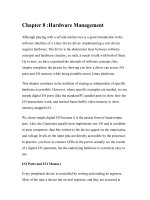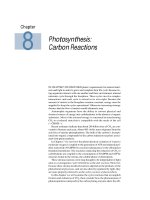Chapter 8 process management
Bạn đang xem bản rút gọn của tài liệu. Xem và tải ngay bản đầy đủ của tài liệu tại đây (625.49 KB, 41 trang )
Chapter 8
PROCESS MANAGEMENT:
JIT & TQM
LEARNING OBJECTIVES
You should be able to:
List & discuss the major elements of lean production & Six Sigma
quality
Describe why lean production & Six Sigma quality are integral
parts of SCM
Discuss the Toyota Production System & its association with lean
production
Discuss the linkage between lean production & environmental
protection
Describe the historical developments of lean production & Six
Sigma
Describe & use the various tools of Six Sigma
Understand the importance of statistical process control for
improving quality
MBA Nguyen Phi Hoang@2015_SCM
2
CHAPTER OUTLINE
•
•
•
•
•
•
•
•
•
•
Introduction
Lean Production & the Toyota Production System
Lean Thinking & Supply Chain Management
The Elements of Lean Production
Lean Systems & the Environment
The Origins of Six Sigma Quality
Comparing Six Sigma & Lean
Six Sigma & Supply Chain Management
The Elements of Six Sigma
The Statistical Tools of Six Sigma
MBA Nguyen Phi Hoang@2015_SCM
3
Introduction
In 1990s, supply chain management combined:
Quick response (QR) - speed & flexibility
Efficient Consumer Response (ECR) - speed &
flexibility
JIT - Continuous reduction of waste
Keiretsu Relationships - Including suppliers in
JIT/TQM efforts
These approaches have emerged as philosophies
& practices known as Lean Production (or Lean
Manufacturing) & Six Sigma
MBA Nguyen Phi Hoang@2015_SCM
4
Lean Production & the
Toyota Production
System
JIT emphasizes
–
Reduction of waste
Continuous improvement
Synchronization of material flows within the
organization
Channel integration- extending partnerships in the
supply chain
Stage 1- Firm is internally focused & functions managed separately.
Silo effect is reactive & short-term goal oriented.
Stage 2- Firm integrates efforts & resources among internal functions.
Stage 3- Firm links suppliers/customers with firm’s processes.
Stage 4- Firm broadens supply chain influence beyond immediate or
first-tier suppliers & customers.
MBA Nguyen Phi Hoang@2015_SCM
5
Lean Production & the
Toyota Production
System
Lean Production
(Continued)
an operating philosophy of waste reduction & value
enhancement & was originally created as Toyota
Production System (TPS) by key Toyota executives
Early versions were based on Ford assembly plants & U.S.
supermarket distribution systems
Key concepts incorporated in TPS are –
• Muda - waste in all aspects of production
• Kanban - signal card & part of JIT
• Statistical process control (SPC) as part of TQM efforts
• Poka-Yoke - error or mistake-proofing
MBA Nguyen Phi Hoang@2015_SCM
6
Lean Production &
Supply Chain
Management
Supply chain
management (SCM) seeks to incorporate
Lean elements using –
cross-training,
satisfying internal customer demand
quickly moving products in the production system
communicating demand forecasts & production
schedules up the supply chain
optimizing inventory levels across the supply chain
Channel integration - extending alliances to suppliers’
suppliers & customers’ customers
The silo effect works against channel integration
MBA Nguyen Phi Hoang@2015_SCM
7
Lean Production &
Supply Chain
Management
Stages of
SCM Evolution
(Continued)
1: Internal
Focused
functional silos
top-down
management
internal
performance
measures
reactive, shortterm planning
no internal
integration
MBA Nguyen Phi Hoang@2015_SCM
2: Functional
Integration
internal flow of
goods
emphasis on
cost reduction
efficiencies
gained by
internal
integration
3: Internal
Integration
4: External
Integration
integration of
flow in firm
lean activities
for goods &
information
measurement
of supplier
performance &
customer
service
integration with
suppliers &
customers
integration
explored w/ 2nd &
3rd tier suppliers &
customers
alliance
development
(Table 8.1)
8
The Elements of Lean
Production
The Elements of Lean
Waste Reduction
Lean Supply Chain Relationships
Lean Layouts
Inventory & Setup Time Reduction
Small Batch Scheduling
Continuous Improvement
Workforce Commitment
MBA Nguyen Phi Hoang@2015_SCM
9
The Elements of Lean
Production
(Continued)
Waste (Muda) Reduction
Firms reduce costs & add value by
eliminating waste from the productive system.
Waste encompasses wait times, inventories,
material & people movement, processing
steps, variability, any other non-value-adding
activity.
Taiichi Ohno described the seven wastes
MBA Nguyen Phi Hoang@2015_SCM
10
The Elements of Lean
Production
(Continued)
The seven wastes
Wastes
Description
Overproducing
Unnecessary production to maintain high utilizations
Waiting
Excess idle machine & operator & inventory wait time
Transportation
Excess movement of materials & multiple handling
Over-processing
Non-value adding manufacturing & other activities
Excess Inventory
Storage of excess inventory
Excess Movement
Unnecessary movements of employees
Scrap & Rework
Scrap materials & rework due to poor quality
MBA Nguyen Phi Hoang@2015_SCM
(Table 8.3)
11
The Elements of Lean
Production
(Continued)
The Five-S’s
Japanese S-Term
English
Translation
English S-Term
Used
1. Seiri
Organization
Sort
2. Seiton
Tidiness
Set in order
3. Seiso
Purity
Sweep
4. Seiketsu
Cleanliness
Standardize
5. Shitsuke
Discipline
Self-discipline
MBA Nguyen Phi Hoang@2015_SCM
(Table 8.4)
12
The Elements of Lean
Production
(Continued)
Lean Supply Chain Relationships
Suppliers & customers work to remove waste,
reduce cost, & improve quality & customer service
JIT purchasing includes delivering smaller quantities,
at right time, delivered to the right location, in the
right quantities
Firms develop lean supply chain relationships with
key customers. Mutual dependency & benefits
occur among these partners.
MBA Nguyen Phi Hoang@2015_SCM
13
The Elements of Lean
Production
(Continued)
Lean Layouts
Move people & materials when & where needed,
ASAP
Lean layouts are very visual (lines of visibility are
unobstructed) with operators at one processing
center able to monitor work at another
Manufacturing cells
Process similar parts or components saving duplication of
equipment & labor
Are often U-shaped to facilitate easier operator & material
movements
MBA Nguyen Phi Hoang@2015_SCM
14
The Elements of Lean
Production
(Continued)
Inventory & Setup Time Reduction
Excess inventory is a waste
Reducing inventory levels causes production
problems
Once problems are detected, they can be solved.
The end result is a smoother running organization
with less inventory investment.
MBA Nguyen Phi Hoang@2015_SCM
15
JIT & Supply Chain
Management
Small Batch Scheduling
Small batch scheduling drives down costs by –
Reducing purchased, WIP, & finished goods inventories
Makes the firm more flexible to meet customer demand
Small production batches are accomplished with the
use of kanbans
Kanbans generate demand for parts at all stages of
production creating a “pull” system
MBA Nguyen Phi Hoang@2015_SCM
16
JIT & Supply Chain
Management
(Continued)
A Kanban Pull System
Final assembly line
Input area
Output area
External
supplies
Mfg. Cell A
Mfg. Cell B
Work cell A
Movement of matl.
into Work cell A
creates a movement
kanban to the
external supplier
MBA Nguyen Phi Hoang@2015_SCM
Movement of matl. to
input area of Work cell B
creates a production
kanban to Work cell A
Movement of matl. into
Work cell B creates a
movement kanban to
Work cell A
(Figure 8.3)
Movement of finished
component to assembly
line creates a production
kanban to Work cell B
17
JIT & Supply Chain
Management
(Continued)
Continuous Improvement (Kaizen)
Continuous approach to reduce process, delivery, &
quality problems, such as machine breakdown
problems, setup problems, & internal quality
problems
Workforce Commitment
Managers must support Lean Production by
providing subordinates with the skills, tools, time, &
other necessary resources to identify problems &
implement solutions
MBA Nguyen Phi Hoang@2015_SCM
18
Lean System & the
Environment
Lean green practices –
Reduce the cost of environmental management
Lead to improved environmental performance.
Increase the possibility that firms will adopt more
advanced environmental management
Carbon-neutral- offsetting the carbon footprint of
a firm’s operations
MBA Nguyen Phi Hoang@2015_SCM
19
The Origins of Six
Sigma Quality
Six Sigma
Near quality perfection (the statistical likelihood
of non-defects 99.99966% of the time)
Pioneered by Motorola in 1987
A statistics-based decision-making framework
designed to make significant quality
improvements in value-adding processes
MBA Nguyen Phi Hoang@2015_SCM
20
The Origins of Six
Sigma Quality
Six Sigma Metrics
# of std dev
above the mean
% of defect-free
output
DPMO
2
69.15
308,537
2.5
84.13
158,686
3
93.32
66,807
3.5
97.73
22,750
4
99.38
6,210
4.5
99.865
1,350
5
99.977
233
5.5
99.9968
32
6
99.99966
3.4
Note: standard deviations include 1.5 sigma “drift”
MBA Nguyen Phi Hoang@2015_SCM
(Table 8.5)
21
Six Sigma & Lean
Production
Lean Six Sigma (Lean Six σ)
Describes the melding of lean production and
Six Sigma quality practices.
Both use –
High quality input materials, WIP, and finished goods
Continuous Improvement (Kaizen)
Lean and Six Sigma use complementary tool
sets and are not competing philosophies
MBA Nguyen Phi Hoang@2015_SCM
22
Six Sigma & Supply
Chain Management
Process integration & communication lead to
fewer negative chain reactions along the supply
chain, such as greater levels of safety stock, lost
time & less productivity
Six Sigma is an enterprise and supply chain-wide
philosophy, that emphasizes a commitment
toward excellence & encompasses suppliers
employees, and customers
MBA Nguyen Phi Hoang@2015_SCM
23
Elements of Six
Sigma
Deming’s Way
1. Create constancy of
purpose to improve product
& service.
2. Adopt the new philosophy.
3. Cease dependence on
inspection to improve
quality.
4. End the practice of
awarding business on the
basis of price.
5. Constantly improve the
production & service
system.
6. Institute training on the job.
MBA Nguyen Phi Hoang@2015_SCM
7. Institute leadership.
8. Drive out fear.
9. Break down barriers
between departments.
10. Eliminate slogans &
exhortations.
11. Eliminate quotas.
12. Remove barriers to pride of
workmanship.
13. Institute program of selfimprovement
14. Put everyone to work to
accomplish the
24
transformation
Elements of Six Sigma
(Continued)
Crosby’s Way
Four Absolutes of Quality
1. The definition of quality is conformance to
requirements
2. The system of quality is prevention.
3. Performance standard is zero defects.
4. The measure of quality is the price of
nonconformance
MBA Nguyen Phi Hoang@2015_SCM
25









